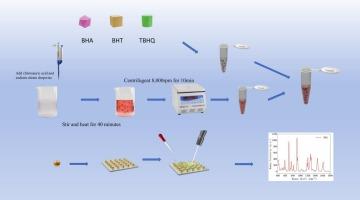结合机器学习的表面增强拉曼光谱检测食用油中的抗氧化剂
IF 4.7
3区 化学
Q2 CHEMISTRY, PHYSICAL
Journal of Photochemistry and Photobiology A-chemistry
Pub Date : 2025-09-08
DOI:10.1016/j.jphotochem.2025.116760
引用次数: 0
摘要
丁基羟基茴香醚(BHA)、丁基羟基甲苯(BHT)和叔丁基对苯二酚(TBHQ)是三种常用的合成抗氧化剂,通常添加到食用油中以防止氧化。然而,由于其毒性,其使用受到限制。在这项研究中,合成了金纳米颗粒(AuNPs)作为表面增强拉曼光谱(SERS)底物,用于快速检测食用油中的抗氧化剂类型和浓度。引入罗丹明作为探针分子验证底物的性能,确定其增强因子为4.4 × 105。利用所制备的底物,可在1000mg /kg ~ 20mg /kg浓度范围内实现抗氧化剂的痕量检测,检出限在10mg /kg以下。此外,采用几种机器学习算法建立抗氧化剂分类和超限检测模型,准确率分别超过99%和94%。这些结果表明,SERS结合机器学习对检测食用油中的抗氧化剂是有效的。本文章由计算机程序翻译,如有差异,请以英文原文为准。

Detection of antioxidants in edible oils using surface-enhanced Raman spectroscopy combined with machine learning
Butylated hydroxyanisole (BHA), butylated hydroxytoluene (BHT), and tert-butylhydroquinone (TBHQ) are three commonly used synthetic antioxidants, often added to edible oils to prevent oxidation. However, their use is limited due to the toxicity. In this study, gold nanoparticles (AuNPs) were synthesized as a surface-enhanced Raman spectroscopy (SERS) substrate for the rapid detection of antioxidant types and concentrations in edible oils. Rhodamine was introduced as a probe molecule to verify the substrate's performance, and the enhancement factor was determined to be 4.4 × 105. Using the fabricated substrate, trace detection of antioxidants was achieved in the concentration range of 1000 mg/kg to 20 mg/kg, with a detection limit below 10 mg/kg. Additionally, several machine learning algorithms were employed to establish models for the classification and over-limit detection of antioxidants, achieving accuracies of exceeding 99 % and 94 %, respectively. These results demonstrate that SERS combined with machine learning is effective for detecting antioxidants in edible oils.
求助全文
通过发布文献求助,成功后即可免费获取论文全文。
去求助
来源期刊
CiteScore
7.90
自引率
7.00%
发文量
580
审稿时长
48 days
期刊介绍:
JPPA publishes the results of fundamental studies on all aspects of chemical phenomena induced by interactions between light and molecules/matter of all kinds.
All systems capable of being described at the molecular or integrated multimolecular level are appropriate for the journal. This includes all molecular chemical species as well as biomolecular, supramolecular, polymer and other macromolecular systems, as well as solid state photochemistry. In addition, the journal publishes studies of semiconductor and other photoactive organic and inorganic materials, photocatalysis (organic, inorganic, supramolecular and superconductor).
The scope includes condensed and gas phase photochemistry, as well as synchrotron radiation chemistry. A broad range of processes and techniques in photochemistry are covered such as light induced energy, electron and proton transfer; nonlinear photochemical behavior; mechanistic investigation of photochemical reactions and identification of the products of photochemical reactions; quantum yield determinations and measurements of rate constants for primary and secondary photochemical processes; steady-state and time-resolved emission, ultrafast spectroscopic methods, single molecule spectroscopy, time resolved X-ray diffraction, luminescence microscopy, and scattering spectroscopy applied to photochemistry. Papers in emerging and applied areas such as luminescent sensors, electroluminescence, solar energy conversion, atmospheric photochemistry, environmental remediation, and related photocatalytic chemistry are also welcome.

 求助内容:
求助内容: 应助结果提醒方式:
应助结果提醒方式:


